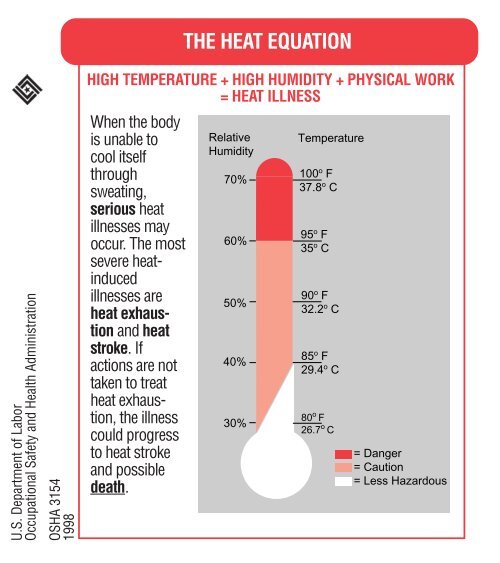6722 HEAT STRESS CARD
6722 HEAT STRESS CARD
6722 HEAT STRESS CARD
Create successful ePaper yourself
Turn your PDF publications into a flip-book with our unique Google optimized e-Paper software.
U.S. Department of Labor<br />
Occupational Safety and Health Administration<br />
OSHA 3154<br />
1998<br />
THE <strong>HEAT</strong> EQUATION<br />
HIGH TEMPERATURE + HIGH HUMIDITY + PHYSICAL WORK<br />
= <strong>HEAT</strong> ILLNESS<br />
When the body<br />
is unable to<br />
cool itself<br />
through<br />
sweating,<br />
serious heat<br />
illnesses may<br />
occur. The most<br />
severe heatinduced<br />
illnesses are<br />
heat exhaustion<br />
and heat<br />
stroke. If<br />
actions are not<br />
taken to treat<br />
heat exhaustion,<br />
the illness<br />
could progress<br />
to heat stroke<br />
and possible<br />
death.<br />
Relative<br />
Humidity<br />
70%<br />
60%<br />
50%<br />
40%<br />
30%<br />
Temperature<br />
100 o F<br />
37.8 o C<br />
95 o F<br />
35 o C<br />
90 o F<br />
32.2 o C<br />
85 o F<br />
29.4 o C<br />
80 o F<br />
26.7 o C<br />
= Danger<br />
= Caution<br />
= Less Hazardous
<strong>HEAT</strong> EXHAUSTION<br />
What Happens to the Body:<br />
HEADACHES, DIZZINESS/LIGHT HEADEDNESS, WEAKNESS,<br />
MOOD CHANGES (irritable, or confused/can’t think straight),<br />
FEELING SICK TO YOUR STOMACH, VOMITING/THROWING UP,<br />
DECREASED and DARK COLORED URINE, FAINTING/PASSING<br />
OUT, and PALE CLAMMY SKIN.<br />
What Should Be Done:<br />
• Move the person to a cool shaded area to rest. Don’t leave the<br />
person alone. If the person is dizzy or light headed, lay them on<br />
their back and raise their legs about 6-8 inches. If the person is<br />
sick to their stomach lay them on their side.<br />
• Loosen and remove any heavy clothing.<br />
• Have the person drink some cool water (a small cup every 15<br />
minutes) if they are not feeling sick to their stomach.<br />
• Try to cool the person by fanning them. Cool the skin with a<br />
cool spray mist of water or wet cloth.<br />
• If the person does not feel better in a few minutes call for<br />
emergency help (Ambulance or Call 911).<br />
(If heat exhaustion is not treated, the illness may advance to<br />
heat stroke.)
<strong>HEAT</strong> STROKE—A MEDICAL EMERGENCY<br />
What Happens to the Body:<br />
DRY PALE SKIN (no sweating), HOT RED SKIN (looks like a<br />
sunburn), MOOD CHANGES (irritable, confused/not making any<br />
sense), SEIZURES/FITS, and COLLAPSE/PASSED OUT (will not<br />
respond).<br />
What Should Be Done:<br />
• Call for emergency help (Ambulance or Call 911).<br />
• Move the person to a cool shaded area. Don’t leave the<br />
person alone. Lay them on their back and if the person is<br />
having seizures/fits remove any objects close to them so<br />
they won’t strike against them. If the person is sick to their<br />
stomach lay them on their side.<br />
• Remove any heavy and outer clothing.<br />
• Have the person drink some cool water (a small cup every<br />
15 minutes) if they are alert enough to drink anything and<br />
not feeling sick to their stomach.<br />
• Try to cool the person by fanning them. Cool the skin with a<br />
cool spray mist of water, wet cloth, or wet sheet.<br />
• If ice is available, place ice packs under the arm pits and<br />
groin area.
How to Protect Workers<br />
• Learn the signs and symptoms of heat-induced illnesses and<br />
what to do to help the worker.<br />
• Train the workforce about heat-induced illnesses.<br />
• Perform the heaviest work in the coolest part of the day.<br />
• Slowly build up tolerance to the heat and the work activity<br />
(usually takes up to 2 weeks).<br />
• Use the buddy system (work in pairs).<br />
• Drink plenty of cool water (one small cup every 15-20<br />
minutes)<br />
• Wear light, loose-fitting, breathable (like cotton) clothing.<br />
•. Take frequent short breaks in cool shaded areas (allow your<br />
body to cool down).<br />
• Avoid eating large meals before working in hot environments.<br />
• Avoid caffeine and alcoholic beverages (these beverages make<br />
the body lose water and increase the risk for heat illnesses).<br />
Workers Are at Increased Risk When<br />
• They take certain medication (check with your doctor, nurse, or<br />
pharmacy and ask if any medicines you are taking affect you<br />
when working in hot environments).<br />
• They have had a heat-induced illness in the past.<br />
• They wear personal protective equipment (like respirators or suits).
















